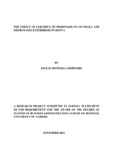| dc.description.abstract | With small and medium size companies operating informal and informal sectors of the economy, they are
likely to face challenges in managing their liquidity which in turn could impact of their profitability. A large
number of these enterprises are faced with various challenges and in particular financial management
expertise. Small and medium-sized enterprises (SMEs) are generally small size; have greater likelihood of
bankruptcy; have greater ability to change the nature of their assets; and also are less transparent in the
information provided to creditors about their specific characteristics. They are there more likely to face
difficulties in accessing external funding, limiting their investment options and possibly leading to sharp falls
in performance in general, and profitability in particular. Therefore, the objective of this research is to
establish the relationship between liquidity and profitability on SMEs in Kenya. The study used a descriptive
research design, a research design in which the major emphasis is on determining the frequency with which
something occurs or the extent to which two variables co-vary. The population of interest in this study was
made up of at least companies and/or establishments registered and operating in Kenya considered being
small and medium size, which is 41, 371 according to the Economic Survey, Kenya National Bureau of
Statistics - Statistical Abstract 2013. The study sample was selected based on convenience sampling. The
study used secondary data which was obtained from annual reports and financial statements of the sampled.
To determine the relationship between liquidity/working capital management and profitability of the
selected SMEs, the study used two types of data analysis techniques, i.e descriptive and quantitative. The
study findings conclude that liquidity has a positive but insignificant effect on profitability. It also concludes
that leverage had a positive but insignificant effect on performance, thus leverage does not affect
profitability of SMEs in Kenya. The findings also conclude that growth as well as size of the firm has a
positive but insignificant effect on profitability and thus these do not affect their profitability. The study
recommends that SMEs should not be concerned much with their levels of liquidity since such levels do not
influence their profitability. However, given that there was an indication of a positive relationship; higher
levels of liquidity may be preferred to lower levels of liquidity if the concern is to improve firm profitability. | en_US |

